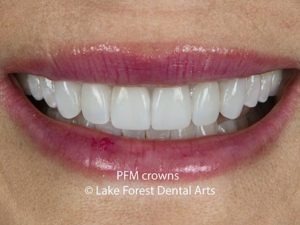
Dental crowns are used every day in dentistry. Many don’t realize that crowns vary in how they are designed, how they fit, and how long they last. Each restoration is custom made to meet the needs of the individual. There are several different types of dental crowns. You may have heard your dentist suggest POM crowns as an option. POM means porcelain on metal or porcelain fused to metal crown. What are the benefits of choosing this type of crown?
If you suspect you may need teeth crowns, schedule a visit at our Chicago area practice.
Types of Dental Crowns
Before we dive into POM crowns, let’s take a look at some of the other types of dental caps:
- All metal or gold: Widely considered the strongest and most durable of crown. All metal restorations are generally crafted from gold or a dark non precious dental alloy. Unfortunately, the gold color is unpopular because it stands out in a smile. For this reason, many patients avoid this option.
- All-ceramic: Made with layers of high-quality dental ceramic, these restorations are incredibly beautiful and lifelike. They even reflect light in a similar fashion as natural teeth. All-ceramic crowns can be an excellent option for restoring front teeth (which are not placed under excessive bite forces). Unfortunately, they may not be strong enough to restore back teeth.
- Stainless steel: These pre-made generic crowns are intended for temporary use. They are often placed in pediatric patients, or may serve as temporary restorations until final crowns can be made.
About POM Crowns
Now that we’ve summed up the other types of dental crowns, we’ll explore POM restorations. These crowns have been considered the “golden standard” for tooth restoration since the late 1950s.
The name actually reveals how a pfm crown is made. The crown is built with a metal supporting base and porcelain is baked on top of it. The end result is a very strong and beautiful crown.
When Are POM Crowns Recommended?
If you have already heard that porcelain crowns are strong, this is absolutely accurate. However, for back, load bearing teeth – or for patients that suffer from bruxism – daily pressure may simply prove too much. If all ceramic crowns were placed in a case like this, they could become damaged quickly under excessive pressure. To avoid this, these crowns are often the best solution. These restorations combine the extraordinary strength and durability of metal with the lifelike beauty of porcelain.
Advantages of POM Crowns
We’ve briefly mentioned why they are such a great choice for certain patients. Let’s take a closer look at some of the benefits of their use:
- Durable: Because they are made with a metal substructure, these caps are much stronger than all-ceramic options. Due to their resiliency, these restorations can be placed on front or back teeth.
- Natural looking: Our restorations are covered with high quality medical grade ceramic. This gives them a natural looking, lifelike appearance.
- Cosmetic improvements: Crowns can be used to make many improvements in your smile. They may be used to straighten teeth or to close gaps between your teeth.
Disadvantages of POM Crowns
There are a few drawbacks to POM restorations:
The “black line” phenomenon:
Because a POM has a metal substructure, it can sometimes appear as a dark line near the gum line. This is especially true in patients who later develop gum recession. However, James Fondriest has a solution for this problem. Working with a world-class ceramist, he always requests that POM restorations be made with a porcelain joint butt margin. This type of margin is designed to hide the metal. The metal is cut back away and only porcelain extends to the edge of the crown. As a result, the dark line is removed.
Slightly less translucency:
All types of all ceramic crowns have more translucency. As a result, the light reflects down the root surface, much like a natural tooth. Because POMs are metal with layered ceramic, they are opaquer. In most cases, however, Dr. Fondriest can make POM crowns appear incredibly lifelike.
Chips in the ceramic:
POMs are strong, but the ceramic they are coated in can still chip or break. That’s why it’s important to avoid harmful habits, such as chewing on ice, pens, or pencils.
Erosion of opposing teeth:
There is a possibility that a POM restoration could wear down the opposing teeth over time. This is more prevalent in those with strong bites or those who suffer from bruxism. To prevent this, dentists can adjust your bite to ensure forces are equalized across all teeth.
How Will My Crown Look?
These beautifully crafted restorations are created by a world famous ceramist. Our natural looking POM crowns will match your shade, shape, and smile. We work with an artistic eye to ensure there is no apparent margin. Instead, your tooth will simply look like a natural tooth.
Crowns can be made of many different materials. Dentists try to match the best crown for each treatment situation. If you are interested in getting another opinion, call our office at 847-234-0517.
Dr Fondriest is a Nationally recognized and highly sought after cosmetic dentist serving clients from throughout the United States
